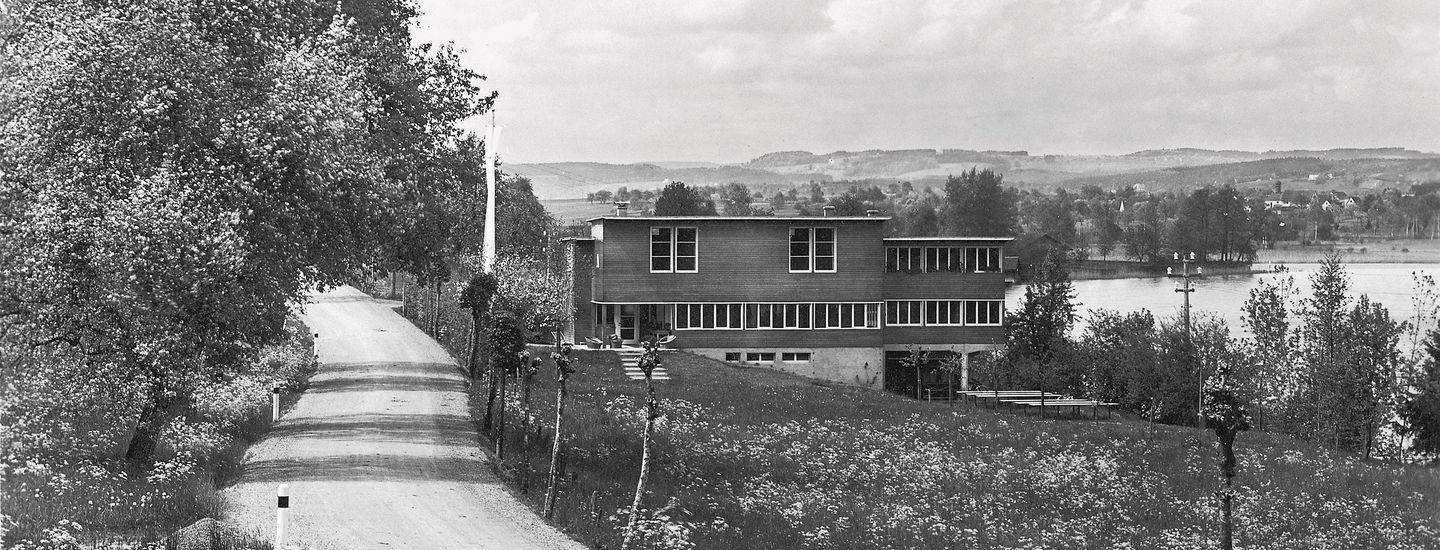
1930 to 1938
Swiss Youth Hostels against the backdrop of the economic crisis, spiritual national defence and fascism
«Good advice for young people who can’t complete their holiday plans or don’t dare to make them because it’s too expensive.» The Association for Youth Hostels Zurich manages a fun holiday home in Toggenburg, 1.5 hours uphill from the Ebnat-Kappel municipality. It is nestled in a serene, expansive landscape and offers plenty of exciting excursions to enjoy. The Bendeli Youth Hostel. The Bendeli hostel is something special. Cosy parlours, comfy beds and a friendly hostel matron known as the «Hausmüetti», who offers full board accommodation for Fr. 3.50 a day. The Hausmüetti is called Miss Siebenhühner and receives enquiries and registrations from young holidaymakers. Address: Jugendferienheim Bendeli ob Ebnat-Kappel, Toggenburg. Now it’s time to make holiday plans: The Bendeli caters to all holiday requirements.»[1]
Many young people are visiting youth hostels such as the Toggenburg Hostel, which is managed by the hostel matron (Hausmutter), Fräulein Siebenhühner.
The hostel matron Fräulein Siebenhühner has her hands full. Opened in 1926 by the Zurich District, the hostel in the canton of St. Gallen enjoys great popularity. The inspiring reports have obviously reached a huge number of young people who – it almost seems – all want to stay overnight in Ebnat-Kappel and other youth hostels. Between 1926 and the outbreak of World War II in 1939, the number of overnight stays and visitors reaches dizzying heights. While the annual report lists 5,000 visitors to the 80 hostels in 1926 and almost 40,000 to 126 hostels in 1930, by 1938 the figure has risen to 105,000 with around 168,000 overnight stays. The peak figure of 208 youth hostels is reached in 1938, while this number falls steady during subsequent years. During the current anniversary years, there are still around 50 youth hostels, which notched up almost 440,000 visitors and around 880,000 overnight stays in 2023.
When it was founded in 1924, it was agreed that the proportion of foreign guests should not exceed 50%. This fear has lacked justification for quite some time. In the first few years, the number of domestic visitors never falls below 80%. During the war years, a figure of almost 100% is reached – although this is not on a voluntary basis. It was not until travel opportunities open up again from 1947 that the figures gradually shift and settle, with around two-thirds of international guests in the 20 years from 1970 to 1990, before returning to the original target around the turn of the millennium. During the two years of the pandemic, more than three-quarters of the «jugis» are occupied by Swiss people, just as they were right at the start.
Wishful thinking and economic reality
The desire for more overnight accommodation and the opening up of new regions of the country is not always accompanied by financial success. The impact of the Great Depression gradually reaches Switzerland. Unemployment rises continuously from 1931 onwards and peaks in 1936 with a rate of 6.4% in January, corresponding to around 124,000 job seekers. Only with the outbreak of the war does the number fall again. There are very few foreign visitors in the tourism sector, as the surrounding countries are doing much worse than Switzerland. Nevertheless, the number of guests at the youth hostels continues to increase. The Bern Association can now finally afford to send a board member on a reconnaissance tour. Marthe Aebischer travels across Valais for two weeks and returns with a list of ten youth hostels at her disposal. These include Les Hudères, where there was a youth hostel until the 1980s, and Champex, which did not close until the second half of the 1990s as part of the restructure.[2]
The dream of owning your own home
Meanwhile, the Zurich Association is dreaming of having its own youth hostel, which it can plan from scratch. It should have a magnificent view and «hostel parents».[3] In October 1931, a small miracle takes place. A generous benefactor donates a piece of land to the association, along with a plan for a hostel in Lenzerheide. The completed building is expected to cost 25,000 francs, with the foundations already in place. However, the area is so remote that an apartment for the hostel parents Frau und Herr Mohler also has to be built in the youth hostel. After a few disagreements with the locals had been resolved, construction progresses quickly and on 1 October 1932 the Zurich district’s first home is inaugurated. Unemployed young people have installed the water pipes, taken over planning work and built a playground. However, the seclusion of the tuffstone building with its panoramic views of the mountain and Lake Heidsee has its pitfalls. For transporting food, the Mohlers rely on a Newfoundland dog, which they use to pull a sledge in winter and a handcart in summer.[4] During the war years, the Mohlers not only struggle with the long distances, but also with the food rationing from the end of August 1939.[5]
As not all young people are able to make the long journey from Zurich to Lenzerheide in their free time, the Greifensee becomes a favoured destination. A farmer by the name of Herr Meier sells a piece of land in Fällanden – «Bei süssem Most» – for a low price. This area known for its cider making was still predominantly rural at the time. In the crisis year of 1936, job creation loans are made available, covering up to one third of the construction costs. Unemployed youngsters create furniture from wood in work camps and help with the construction of the building designed by renowned architect Emil Roth.[6] Dormitories and a sophisticated gender segregation system elevate the building to a real showpiece.[7] On 6 June 1937, the «dream hostel» is inaugurated, just as it had been envisaged and described almost to a tee by Getrud Honegger years earlier: A simple, functional, modern building with no frills.
The district of Lucerne manages to courageously purchase its own hostel in a prime location in 1930 before the inhabitants of bustling Zurich purchased theirs. The Rotschuo youth holiday home is located between Vitznau and Gersau on Lake Lucerne. The youth hostels in Central Switzerland can hardly believe their luck: «It’s fair to say that if the world crisis of 1930 had not created so many difficulties, the entire Lake Lucerne Riviera from Hertenstein to Gersau would probably have been completely occupied by private individuals.»[8] In light of the crisis in Europe, they stress the importance of doing something for the younger generation: «In these troubled times, in particular, it is very important that young people are able to go back to their roots, and is why our own vegetable garden and barn with the three cows at the ‘Rotschuo’ are particularly important.»[9]
From the mid-1930s, fear of war begins to spread in Switzerland. In view of the threat posed to Switzerland by National Socialist Germany, the idea of the Spiritual National Defence[10] is becoming increasingly important. Political and intellectual circles as well as the media are calling for measures to strengthen the fundamental cultural values of Switzerland. The country should unite across language barriers, social groups and political divides. Young people are also required to be good citizens, to love their home country and to appreciate their «little plot of land» known as a «Scholle,» such as the land that was cared for at the Rotschuo hostel.
From the very beginning, the Swiss Youth Hostels emphasise their political and religious independence, while also pursuing the ideals of peace and international solidarity. For example, when the Spanish War led by the fascist Franco regime breaks out in 1936, Spanish children find shelter in a Swiss youth hostel. The Swiss Worker’s Relief Organisation (SAH) takes them from the war zone to Switzerland to recover and looks after them. [11]
[1] Berner Schulblatt, 1935, Heft 16, 20. Juli 1935, S III
[2] Cf. Alain Paratte, 1991, p. 36.
[3] Cf. 50 Years of the Zurich Youth Hostels Association, 1974, p. 10.
[4] Cf. 50 Years of the Zurich Youth Hostels Association, 1974, p. 12.
[5] Find out more about food rationing here: hls-dhs-dss.ch/de/articles/013782/2010-08-02/
[6] Cf. 50 Years of the Zurich Youth Hostels Association, 1974, p. 15, and A. Furrer, Was ist eine Jugendherberge, in: Das Werk: Architektur und Kunst, Band 30, Heft 1, 1943
[7] «The requirements stipulated by the Zurich Youth Hostels Association in its capacity as building owner for this new building were based on many years of experience with similar hostels, some of which are operated as self-built buildings and some as rental properties. The most important requirement was that the hostel should be as flexible as possible to accommodate the fluctuating numbers of boy and girl visitors. This results in the hostel being clearly partitioned into medium to smaller-sized sections. The bedrooms, together with a communal washroom, are divided into two groups separated by gender. Each group contains two dormitories, each with ten two-tier bunk beds and a bedroom each for just four young people. Two separate areas are available for communal living: a large day room and a small one, which is used particularly when activities are limited, when the weather is unpredictable or in the cooler months of the year.» Architect Alfred Roth (cousin of Emil Roth) on the spatial organisation of the hostel in: Das Werk: Architektur und Kunst, (The Work: Architecture and Art) Volume 30, Issue 1, 1943
[8] Pro Juventute, 1932, page 286.
[9] Pro Juventute, 1932, page 286.
[10] Cf., for example, hls-dhs-dss.ch/de/articles/017426/2006-11-23/
[11] Cf. www.republik.ch/2019/10/19/jenseits-der-vorfuehrung












Share this page